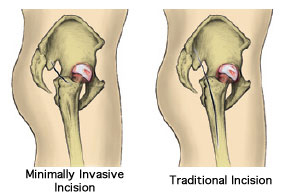Minimally Invasive Total Hip Replacement
Procedure:
In minimal invasive surgery, only two small incisions are needed for carrying out the surgery. This surgery is also called as laparoscopic surgery / arthroscopy / keyhole surgery. Muscle dissection will also be minimal in this surgery. The surgeon makes use of X-ray images to visualize the organs that he is operating and for fixing the artificial hip in its position. Surgeons experience and his learning curve are matters of crucial importance in the success of a minimal invasive hip replacement surgery.
Hip replacement surgery is one of the most successful surgeries that have been carried out very frequently. In traditional hip replacement surgery, an incision of length 6 to 8 eight inches is needed and muscles dissection is also more in this case. Though this has been found to be a very successful procedure, the advancement in technology and mans search for easy and less painful surgeries clubbed with the advancement in medical technology has paved way for new procedures like minimum invasive hip replacement surgery. The incisions are small the wound heals faster and the patient can attend to his usual work at an early date. It is the responsibility of the surgeon to find out which is the most suitable course of action for a particular person and to give him a detailed briefing about the pros and cons of the procedure selected for him.
What to expect after the surgery
Only limited movement facility will be available for the first few days after the surgery. Pillows or other suitable devices will be provided for you to keep the hip in the correct position. Fluids will be supplied to you through an intravenous tube to substitute for the loss of fluids that occurred during the surgery. Your urine will be drained through a catheter till you are able to use the toilet for this purpose. A therapist will teach you the exercises you will have to do to improve recovery and return to normal life. After one or two days you will be able to sit on the bed and walk a few steps with assistance. Therapist will help you to perform normal activities like sitting, bending etc. After 3 to 4 days stay in the hospital you will be able to return home. It may take three to six months for complete recovery and return to normalcy.

